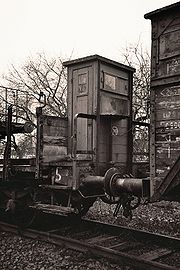
Brakeman's cabin
Encyclopedia


Brakeman
A brakeman is a rail transport worker whose original job it was to assist the braking of a train by applying brakes on individual wagons. The advent of through brakes on trains made this role redundant, although the name lives on in the United States where brakemen carry out a variety of functions...
from the weather and in which equipment for manually operating the wagon brake was located. They were built in the days before continuous braking was available and the locomotive brake needed to be augmented by brakemen applying the wagon brakes individually.
In the early years of the railway, brakemen just had an open seat. The first cabs appeared around 1880. The number of brakeman's cabs occupied in a given train depended on the conditions of the route and the speed of the train; on some trains all the cabs might be occupied. Communication between engine driver and brakemen was by train whistle signals which required the design of the brakeman's cab to be partially open to the elements.
Working in brakeman's cabins was dangerous, especially in winter
Winter
Winter is the coldest season of the year in temperate climates, between autumn and spring. At the winter solstice, the days are shortest and the nights are longest, with days lengthening as the season progresses after the solstice.-Meteorology:...
because the cabins were unheated and draughty and there was little room to move around and keep warm. As a result brakemen frequently froze, sometimes even to death, placing the entire train at risk due to lack of braking power.
Brakeman's cabins became superfluous with the widespread introduction of compressed air brakes. In Germany, such brakes first appeared on D-Zug (express) trains at the end of the 19th century.
The building of brakeman's cabins stopped on German passenger trains in the early 1900s and on goods trains around 1925. In the United States such cabs continued to be built until about 1910 for passenger coaches and until about 1950 on goods wagons.

